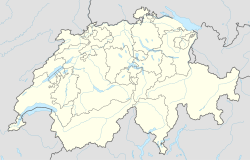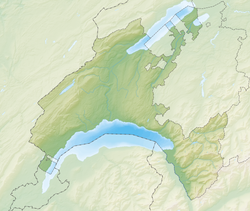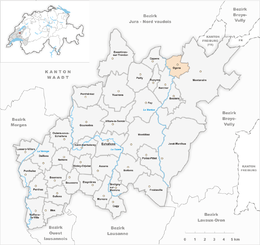Ogens
| Ogens | ||
|---|---|---|
 |
||
|
||
| Coordinates: 46°43′N 6°43′E / 46.717°N 6.717°ECoordinates: 46°43′N 6°43′E / 46.717°N 6.717°E | ||
| Country | Switzerland | |
| Canton | Vaud | |
| District | Gros-de-Vaud | |
| Government | ||
| • Mayor | Syndic | |
| Area | ||
| • Total | 3.41 km2 (1.32 sq mi) | |
| Elevation | 629 m (2,064 ft) | |
| Population (Dec 2015) | ||
| • Total | 283 | |
| • Density | 83/km2 (210/sq mi) | |
| Postal code | 1045 | |
| SFOS number | 5680 | |
| Surrounded by | Bercher, Bioley-Magnoux, Correvon, Oppens, Saint-Cierges, Thierrens | |
| Website |
http://www.ogens.ch Profile (French), SFSO statistics |
|
Ogens is a municipality in the district of Gros-de-Vaud in the canton of Vaud in Switzerland.
Ogens is first mentioned in 1166 as Ogens.
Ogens has an area, as of 2009[update], of 3.4 square kilometers (1.3 sq mi). Of this area, 2.09 km2 (0.81 sq mi) or 61.3% is used for agricultural purposes, while 1.03 km2 (0.40 sq mi) or 30.2% is forested. Of the rest of the land, 0.27 km2 (0.10 sq mi) or 7.9% is settled (buildings or roads).
Of the built up area, housing and buildings made up 4.4% and transportation infrastructure made up 3.2%. Out of the forested land, 28.7% of the total land area is heavily forested and 1.5% is covered with orchards or small clusters of trees. Of the agricultural land, 49.3% is used for growing crops and 11.7% is pastures.
The municipality was part of the Moudon District until it was dissolved on 31 August 2006, and Ogens became part of the new district of Gros-de-Vaud.
The municipality is located between Echallens and Payerne. It consists of the linear village of Ogens, on a plateau along the right bank of the Mentue river.
The blazon of the municipal coat of arms is Per pale Gules and Vert, overall a Billy-goat rampant Argent.
Ogens has a population (as of December 2015[update]) of 283. As of 2008[update], 6.5% of the population are resident foreign nationals. Over the last 10 years (1999–2009 ) the population has changed at a rate of 14.3%. It has changed at a rate of 7.8% due to migration and at a rate of 6.9% due to births and deaths.
...
Wikipedia




